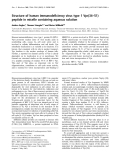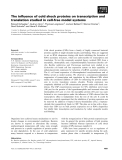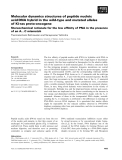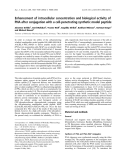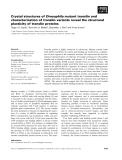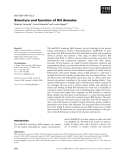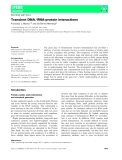
Nucleic acid structure
-
Human immunodeficiency virus type 1 protein R (HIV-1 Vpr) promotes nuclear entry of viral nucleic acids in nondividing cells, causes G2 cell cycle arrest and is involved in cellular differentiation and cell death. Vpr subcellular localization is as variable as its functions. It is known, that consistent with its role in nuclear transport, Vpr localizes to the nuclear envelope of human cells. Further, a reported ion channel activity of Vpr is clearly dependent on its localization in or at membranes.
 6p
6p  system191
system191
 01-06-2013
01-06-2013
 33
33
 4
4
 Download
Download
-
Cold shock proteins (CSPs) form a family of highly conserved bacterial proteins capable of single-stranded nucleic acid binding. They are suggested to act as RNA chaperones during cold shock inhibiting the formation of RNA secondary structures, which are unfavourable for transcription and translation.
 12p
12p  fptmusic
fptmusic
 12-04-2013
12-04-2013
 37
37
 2
2
 Download
Download
-
The low affinity of peptide nucleic acid (PNA) to hybridize with DNA in the presence of a mismatch endows PNA with a high degree of discriminat-ory capacity that has been exploited in therapeutics for the selective inhibi-tion of the expression of point-mutated genes. To obtain a structural basis for this intriguing property, molecular dynamics simulations are carried out on PNAÆDNA duplexes formed at the Ki-ras proto-oncogene, compri-sing the point-mutated (GAT), and the corresponding wild-type (GGT) codon 12. ...
 16p
16p  fptmusic
fptmusic
 11-04-2013
11-04-2013
 52
52
 2
2
 Download
Download
-
In order to evaluate the ability of the cell-penetrating a-helical amphipathic model peptide KLALKLALKALK AALKLA-NH2 (MAP) to deliver peptide nucleic acids (PNAs) into mammalian cells, MAP was covalently linked to the 12-mer PNA 5¢-GGAGCAGGAAAG-3¢ directed against themRNAof the nociceptin/orphaninFQ receptor. The cellular uptake of both the naked PNA and its MAP-conjugate was studied by means of capillary electrophoresis combined with laser-induced fluorescence detection, confo-cal laser scanningmicroscopyandfluorescence-activatedcell sorting. ...
 0p
0p  awards
awards
 05-04-2013
05-04-2013
 32
32
 2
2
 Download
Download
-
Translin protein is highly conserved in eukaryotes. Human translin binds both ssDNA and RNA. Its nucleic acid binding site results from a combina-tion of basic regions in the octameric structure. We report here the first bio-chemical characterization of wild-typeDrosophila melanogaster(drosophila) translin and a chimeric translin, and present 3.5 A ˚ resolution crystal struc-tures of drosophila P168S mutant translin from two crystal forms.
 15p
15p  galaxyss3
galaxyss3
 07-03-2013
07-03-2013
 54
54
 5
5
 Download
Download
-
The hnRNP K homology (KH) domain was first identified in the protein human heterogeneous nuclear ribonucleoprotein K (hnRNP K) 14 years ago. Since then, KH domains have been identified as nucleic acid recognition motifs in proteins that perform a wide range of cellular functions.
 15p
15p  media19
media19
 06-03-2013
06-03-2013
 34
34
 3
3
 Download
Download
-
PARP-like zinc fingers (zf-PARPs) are protein domains apt to the recogni-tion of multiple DNA secondary structures. They were initially described as the DNA-binding, nick-sensor domains of poly(ADP-ribose)polymerases (PARPs). It now appears that zf-PARPs are evolutionary conserved in the eukaryotic lineage and associated with various enzymes implicated in nucleic acid transactions.
 11p
11p  media19
media19
 06-03-2013
06-03-2013
 29
29
 3
3
 Download
Download
-
Alternate DNA structures that deviate from B-form double-stranded DNA such as G-quadruplex (G4) DNA can be formed by sequences that are widely distributed throughout the human genome. G-quadruplex secondary structures, formed by the stacking of planar quartets composed of four guanines that interact by Hoogsteen hydrogen bonding, can affect cellular DNA replication and transcription, and influence genomic stability.
 19p
19p  viettel02
viettel02
 19-02-2013
19-02-2013
 30
30
 4
4
 Download
Download
-
The great pace of biomolecular structure determination has provided a plethora of protein structures, but not as many structures of nucleic acids or of their complexes with proteins. The recognition of DNA and RNA molecules by proteins may produce large and relatively stable assemblies (such as the ribosome) or transient complexes (such as DNA clamps sliding through the DNA).
 8p
8p  cosis54
cosis54
 05-01-2013
05-01-2013
 45
45
 5
5
 Download
Download
CHỦ ĐỀ BẠN MUỐN TÌM








